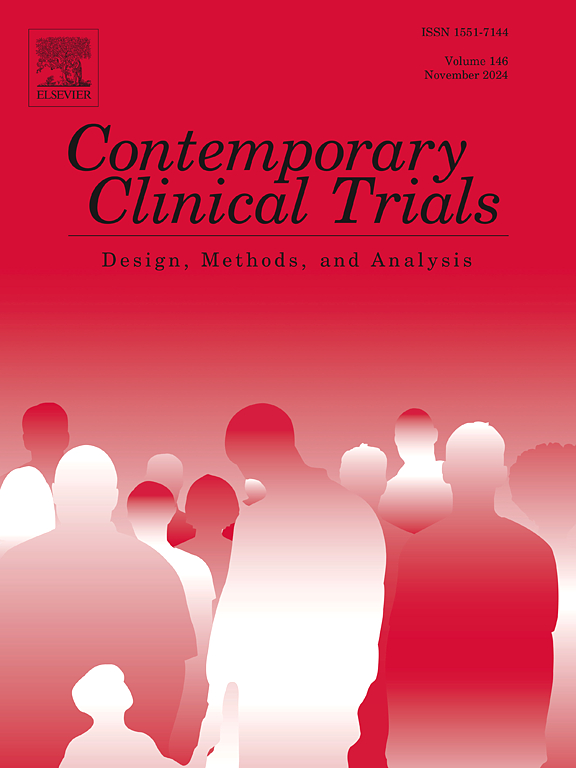招募老年人参加行为干预研究的策略的成功和成本效益。
IF 1.9
3区 医学
Q3 MEDICINE, RESEARCH & EXPERIMENTAL
引用次数: 0
摘要
背景:随着老年人口的增长,越来越需要关注与年龄相关的研究。然而,由于许多因素,招聘这一人群可能很困难。因此,迫切需要了解哪些招募方法在老年人中产生最成功和最具成本效益的结果。方法:采用多种招募策略招募200名老年人(60-85岁)参加一项随机对照试验,研究行为睡眠干预对认知功能的影响。评估了每种策略的成功和成本效益,包括招募参与者的百分比、联系人到注册的转化率、总成本和每位参与者的成本。结果:总接触到注册的转化率为10.2% %,总招募成本为20,220美元,每个参与者的成本为101美元。最高比例的参与者(49% %)是通过阿尔茨海默病研究中心(KU ADRC)注册中心招募的,该中心的总成本最高(13,175美元)。广播广告、平面广告和KU ADRC注册都具有较高的转化率(19-33 %)和较高的人均成本(134-227美元)。Facebook广告和好友/家人推荐的每参与者成本较低(分别为17美元和0美元),转化率较高(两者均为23. %),但只提供了10. %的注册参与者。结论:在行为研究中,利用多种招聘资源是成功招聘的关键。除了Facebook和家人/朋友推荐外,每位参与者成本较高的招聘资源往往具有最高的转化率。虽然高成本策略可能是必要的,但包括关系和基于社交媒体的策略可能为招募老年人提供成本效益高的方法。本文章由计算机程序翻译,如有差异,请以英文原文为准。
Success and cost-effectiveness of strategies to recruit older adults to a behavioral intervention research study
Background
With a growing population of older adults, there is an increased need to focus on age-related research. However, recruiting this demographic can be difficult due to numerous factors. Therefore, there is a critical need to understand which recruitment methods yield the most successful and cost-effective results amongst older adults.
Methods
Multiple recruitment strategies were employed to enroll 200 older adults (ages 60–85) into a randomized controlled trial investigating the impact of a behavioral sleep intervention on cognitive function. Success and cost-effectiveness of each strategy was evaluated, including percentage of participants recruited, contact-to-enrolled conversion percentage, overall cost, and cost per participant.
Results
The total contact-to-enrolled conversion rate was 10.2 % with an overall recruitment cost of $20,220 and a per-participant cost of $101. The highest percentage of enrolled participants (49 %) was recruited through the Alzheimer's Disease Research Center (KU ADRC) registry, which had the highest overall cost ($13,175). Radio advertisements, print advertisements, and KU ADRC registry had both high conversion rates (19–33 %) and high per-participant costs ($134–227). Facebook advertisements and friend/family referrals had low per-participant costs ($17 and $0, respectively) and high conversion rates (23 % for both), but only provided 10 % of the enrolled participants.
Conclusion
Utilizing multiple recruitment sources is essential for successful recruitment into behavioral research studies. Recruitment sources with higher costs per participant tended to have the highest conversion rate, apart from Facebook and family/friend referrals. While high-cost strategies are likely necessary, including relational and social media-based strategies may offer cost-effective methods for recruiting older adults.
求助全文
通过发布文献求助,成功后即可免费获取论文全文。
去求助
来源期刊
CiteScore
3.70
自引率
4.50%
发文量
281
审稿时长
44 days
期刊介绍:
Contemporary Clinical Trials is an international peer reviewed journal that publishes manuscripts pertaining to all aspects of clinical trials, including, but not limited to, design, conduct, analysis, regulation and ethics. Manuscripts submitted should appeal to a readership drawn from disciplines including medicine, biostatistics, epidemiology, computer science, management science, behavioural science, pharmaceutical science, and bioethics. Full-length papers and short communications not exceeding 1,500 words, as well as systemic reviews of clinical trials and methodologies will be published. Perspectives/commentaries on current issues and the impact of clinical trials on the practice of medicine and health policy are also welcome.

 求助内容:
求助内容: 应助结果提醒方式:
应助结果提醒方式:


